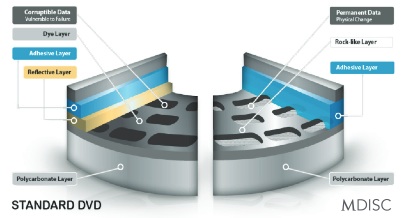Development of CD-R Optical Disc
The first commercially-available recordable optical disc was a CD-R, introduced in 1988 as an outgrowth of
the CD audio or music disc. Based on organic cyanine dyes, these earliest recordable discs were, by nature,
chemically unstable which caused them to fade and become unreadable within a few years. Chemical
stabilizers were eventually added to the manufacturing process, but the dye-based discs were still sensitive
to UV light and would often fail after only one week of exposure to sunlight.
A less UV-sensitive Phthalocyanine dye was later developed that was natively stable and required no
chemical stabilizers. However, this dye was much more sensitive to laser power calibration errors and a
difficult to achieve high quality write process. A third even less UV-sensitive Metallic Azo dye was later
added to the market. This material also required no chemical stabilizers and could withstand several weeks
of direct sunlight exposure, but still had a lifetime rating of decades, with real-world experience usually
realizing a fraction of that.
From CD-R to Recordable DVDs
Early DVD recordables used hybrid versions of these dyes but because they utilized much thinner recording
layers they were much more sensitive to oxidation and dye degradation. Recordable DVDs performed
poorly in longevity testing and were determined to be even less suitable than CD-Rs for archival use.
Rewritable CDs & DVDs
Rewritable CDs and DVDs are based on a different technology than write once discs. A thin recordable layer
is created by alloying antimony, germanium and tellurium. These three metals combined in tightly controlled
amounts produce a rewritable layer that can be recorded and rewritten many times. The write process involves
heating the write layer to two set temperature points. The higher temperature is known as the melting temperature
and a lower temperature is known as the crystallization temperature. Heating the disc and controlling the rate of
cooling with the write laser produces a series of amorphous and crystalline marks along the track. The difference
in reflectivity between these areas produces a signal similar to but less reflective than that of a pressed optical
disc. These "Phase Change"" discs performed a little better in longevity testing, but since they could be easily
erased by a standard drive they were not suitable choice for archival applications.

CD-R & DVD-R Longevity Concerns
The factor that defines the longevity of CD-R and DVD-R is the material in the write layer. The organic dye
materials selected for CDs and then translated over to DVDs were chosen because of their compatibility with
the laser and drive technology available
at the time. They were not chosen with
stability and longevity as primary goals.
The materials selected for the M-DISC™
were chosen with stability and longevity as
the primary goal. They were also chosen
because they enabled the use of a more
durable data mark - a physical hole or pit
that could be formed in the data layer.
Stability & Longevity - Why Physical Pits are Better
This new physical recording mechanism works with the durability of the materials in the data layer to enhance the
stability of the data. For example, the movement of material during the formation of the pit actually strengthens
the edge of the mark-a significant advantage over the optical dye or phase-change data mark. Since the nano-
meter scale location of the edges is critical to the retention of data, enhancing the edges (shown in the nearby
scanning electron microscope image) builds longevity. This permanent optical contrast, resulting from
the physical mark, provides secure data retention and disc readability decades into the future.
For additional information about this product line, please go to our M-DISC™ Information Page.
You can also view or download this information here.